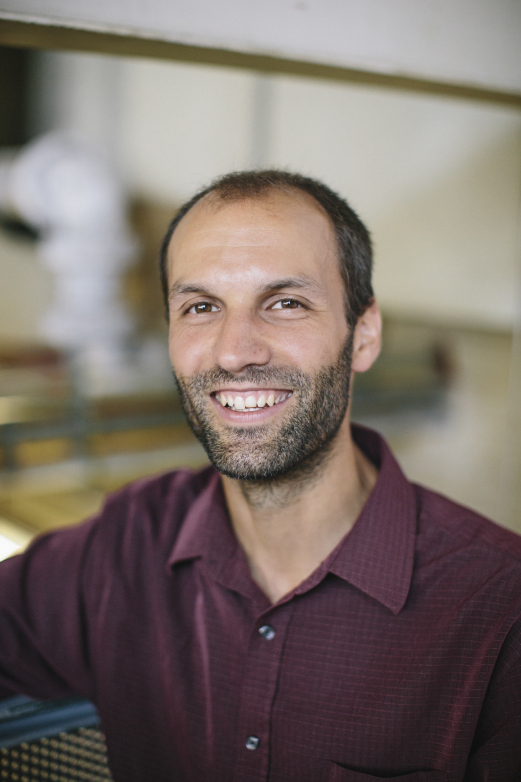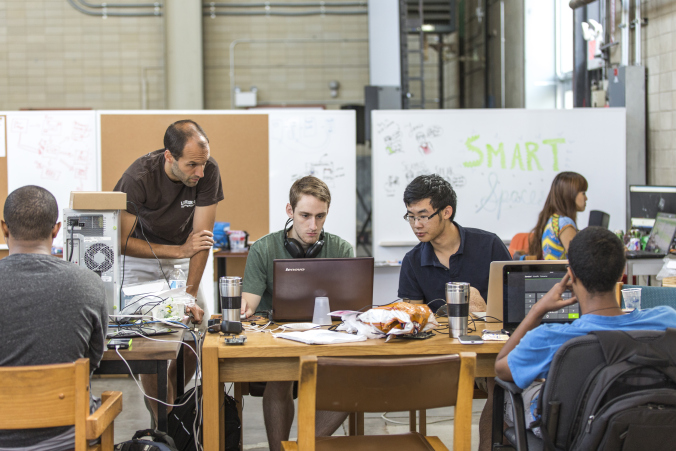Mountaintop Mentor - Michael Spear

Michael Spear is a Mountaintop Mentor for the student research group, Smart Spaces in Summer 2014
Last week, we profiled the student research projects under the Smart Spaces umbrella. These projects aim to develop intelligent technology for living spaces. Michael Spear, assistant professor of computer science and engineering at Lehigh, is one of the professors mentoring students on the various projects that fall under Smart Spaces. Here, he tells us why he got involved, what his students are learning and why BIG — is definitely better — at Mountaintop.
Give us your take/opinion on Mountaintop & the unique experience it provides participating students.
One of the most exciting aspects of Mountaintop is that it provides an opportunity for hands-on learning and putting ideas into practice. In the classroom, it’s easy to overlook how much of a problem has already been defined, designed, and solved, before students even read the assignment. At Mountaintop, students do all of the initial work, instead of just producing the end result. In our project, this means that the students aren’t just figuring out how to make clients talk to existing servers. They are also building the servers and inventing the protocols that the servers will use to listen to the clients. It means that when they build a sensor device, they have to think through issues related to power, reliability, and maintenance. In the classroom, we often don’t get a chance to emphasize these practical aspects of engineering or to require students to build a complete, end-to-end system. But at Mountaintop, these are first-class topics.
The other part of the Mountaintop experience that I think is so fun is that the students can define the scope… and then they have to live with it. There are so many intricacies that arise when you build something that other people have to use and interact with, as opposed to something that a professor asks you to build for a class. In our project, where we are trying to build a physical space that responds to the people inside of it, the students are not allowed to post instructions on the wall, or tell people how to act when they are in the space. The space has to do what the students originally envisioned. It has to be futuristic. It has to be really smart.
A small example of this is that we have a voice-recognition system that is always listening for instructions. I think it was a big surprise for the students to realize what it really means if the system has to always listen! They couldn’t say “stand in the corner near the microphone when you want to give voice commands”. They couldn’t say “turn on this program when you want the space to start listening to you”. Instead the system has to be listening all the time. It has to know how to ignore noise most of the time. It has to be energy efficient when it isn’t in use. And it has to be ready to respond to lots of different voices at any time, without warning.
How/why did you get involved with this project/these students?
As a professor, I love guiding students as they learn on their own. As an engineer, it is exciting to have the opportunity to lead a team working on big problems in a one-of-a-kind space. So when I learned that I could combine these two passions, it was an opportunity I couldn’t pass up.
What value does this space/approach to learning at Mountaintop do for this project in particular?
There are a lot of aspects of the Mountaintop space that are big enablers for us. The first was that we had enough room for everyone to do what they needed to do. In an electrical engineering lab, there aren’t many workstations for doing serious programming. In computer science labs, there aren’t stations for soldering. Neither sort of lab has enough floor and table space for 10 people to stand around something a student built and watch how it behaves. But at Mountaintop, there’s enough room for students in different fields to work side-by-side, to have the resources and equipment they need, while all still being in the same place and interacting with each other all the time.
Another big enabler was that we had enough room to go ahead and build a mock-up room and start installing our devices into it. Our smart room is 10 feet high… you can’t build a 10-foot high room inside of Packard Lab, and then be able to stand on top of the roof to install cameras in the ceiling. If we couldn’t build the space, we wouldn’t have been able to test out nearly as much, or to run into all of the headaches (well, let’s call them “learning experiences”) that arise when you try to integrate so many different components into one system. Simply put, if we didn’t have so much room, we would have ended up with eight or ten small projects that never coalesced into one big project. And the physical size of our project is part of what makes it so valuable.
What challenges do you think your team will encounter during their project?
The biggest challenges are never technical. The biggest challenges have to do with how the students will learn, and how they will respond to the changes that happen during the course of the project.
Students are going to discover that some things they thought were easy are actually really hard, and some things they thought were hard are easy. That’s a natural part of problem solving. But what’s really fun is to see how they respond to these discoveries. Will realizing that something is easy inspire the students to try to do much more than they originally planned? Will the discovery that something is difficult lead them to redouble their efforts, or to try to redefine the problem to make it easier? How will students change their work habits in response to success? In response to failure? How well will they learn to work together, and to know when they need help? Will they be confident enough to seek that help?
It’s easy to look at our students, who are incredibly smart, and forget that they are 19 years old. It’s easy to forget that this is the biggest project they’ve ever worked on. And so I think the biggest challenge, or at least the biggest source of uncertainty, is that I can’t predict how much personal growth is going to take place. But in the end, that’s part of the joy of being a professor- that I get to watch and guide students during this process of self-discovery. And in the end, I’ll probably end up learning a lot about myself, too.
Posted on:





